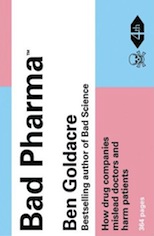“I’m going to tell you how medicine works, in one paragraph that will seem so ludicrously appalling that when you read it you’ll probably assume I’m exaggerating,” writes Ben Goldacre on the first page of his new book, Bad Pharma: How drug companies mislead doctors and harm patients.
He goes on to clarify that “this whole book is about meticulously defending every assertion” in that paragraph – and meticulously defend them he does.
The paragraph is over 300 words long; here are just 50 of them:
“Drugs are tested by the people who manufacture them, in poorly designed trials, on hopelessly small numbers of patients, and analysed using techniques which are flawed by design, in such a way that they exaggerate the benefits of treatments. Unsurprisingly, these trials tend to produce results that favour the manufacturer.”
The first 100 of the book’s 400 pages are devoted to one disturbing issue: missing – or more specifically hidden – data.
Before a drug can go on the market to be prescribed by doctors and make money for the company that developed it, it must be approved by regulators.
In order to achieve this a company generally has to provide at least two or three clinical trials showing that its drug works. In a clinical trial, the drug is given to real patients for a period of time, and their results are compared to those of patients receiving either a different treatment, or a placebo.
If a company were to conduct seven trials into a drug, five of which showed it to be either ineffective or dangerous, it would obviously give a very distorted picture of reality if only the two other trials, the positive ones, were published and publicised.
But, reveals Goldacre, companies are not only perfectly entitled to conduct as many trials as they wish and then cherry pick which ones to publish; the practice is endemic throughout the whole of orthodox medicine.
The result? “We have no idea which treatments are best and by extension we have no idea which are harmful.”
Indeed, because companies are free to bury any result they please, “patients are exposed to harm on a staggering scale throughout the whole of medicine. Doctors can have no idea about the true effects of the treatments they give. Does this drug really work best, or have I simply been deprived of half the data? Nobody can tell. Is there any evidence that this drug is dangerous? No one can tell.”
These are shocking allegations coming from a medical doctor, yet to say that they are – as the author promised at the outset – “meticulously defended” in the text, would be an understatement.
Orthodox medicine’s entire evidence base has, he writes, “been systematically distorted by the pharmaceutical industry, which has deliberately and selectively withheld trials whose results it didn’t like, while publishing the ones with good results.”
And lest the implications of all this be lost on any reader he also points out, several times, that, “Medical research isn’t an abstract academic pursuit. Every time we fail to publish a piece of research we expose real, living people to unnecessary, avoidable suffering.”
Here’s just one of the many examples he gives to illustrate how out of hand things are: in 2008 a group of researchers decided to look at the trial data behind the antidepressants that came onto the market between 1987 and 2004. They found 74 trials in total, representing 12,500 patients’ worth of data. 38 had positive results, with a finding that the new drug worked, while 36 had negative findings.
Of the 38 positive trials, 37 had been published in full, “often with much fanfare”. Of the 36 with negative results, only 3 had been published. Worse still, 11 of the trials with negative results were written up in the academic literature as successes.
So in reality there were 38 positive trials and 37 negative ones, but according to the literature, there were 48 positive trials and 3 negative ones.
Goldacre clarifies that this involved 12 drugs and all the major manufacturers, “with no stand-out bad guy. It very clearly exposed a broken system.”
Several times in the book, Goldacre introduces a quote he knows will appal the reader with the words, “This is not a smoking gun” – wearily adding that it’s normal industry practice; just the everyday reality of how medicine works.
He also makes the distinction that, “It’s possible for good people, in perversely designed systems, to casually perpetrate acts of great harm on strangers, sometimes without even realising it.”
A further health issue he highlights is that we know very little about drug side effects as there is not nearly the coordinated system you’d hope there would be for collecting and analysing information on them.
When a doctor sees a common symptom or condition – he specifies cancer as one example – it may never even occur to him or her that this is anything to do with a prescription they’ve given due to the “high background rate of people who suffer from them, and this will be especially true if they occur a long time after a patient starts on a new drug.”
And as this book painstakingly shows, the current system can’t be relied on even to accurately pinpoint a drug’s overt short-term side effects.
The cumulative and often hidden effects on the body of taking a drug – or, as many do, a cocktail of drugs – every day for years? “Evidence-based medicine” doesn’t even pretend to be keeping tabs on that.
As Goldacre spells out – though it’s stating the obvious by this point – the main objective of clinical trials is to “make a drug look good so that regulators, doctors and patients will swallow it.”
The last section of the book reports on the questionable and in some cases indefensible ways in which pharmaceutical companies market their drugs, mainly to doctors.
For example, a study which looked at adverts in medical journals found that only half of the claims made about the drugs advertised were supported by the trials the adverts referenced as evidence, and that only half of those trials scored as high quality.
Worse still, Goldacre cites the case of a respected academic publisher which was found to be producing entire “medical journals” on behalf of the pharmaceutical giant Merck.
This is the longest chapter in the book and also covers (among other things) the payments and other perks many doctors receive from pharmaceutical companies, and the fact doctors get most of their “continuing medical education” from – would you believe? – pharmaceutical companies.
Throughout the text Goldacre suggests many solutions that can and should be implemented.
But he points out, more than once, that the practices described in the book have been polluting the evidence base for so long that “even if we fixed this today – right now, for good, forever, without any flaws or loopholes in legislation” doctors would still be making treatment decisions every day “on the basis of medical evidence which is fundamentally distorted.”
This book barely touches on an issue of equal if not greater magnitude. The system is not merely rigged so that it’s a lot easier than it should be for pharmaceutical companies to get their drugs approved and widely used.
It is rigged so that pharmaceutical drugs dominate medical research, training and practice orders of magnitude more than they would if the industry were truly structured to favour the public interest.
If the day comes when the way in which drugs are tested, approved and prescribed actually deserves the label “evidence-based medicine” that will be a vast and important improvement, and that improvement is what this book is about.
I don’t know about you, but I wouldn’t want to live in a world without anaesthetics, nor without antibiotics (judiciously used), nor any of the other drugs that genuinely save lives or make lives better.
But – and for clarity, the following is my opinion, not Goldacre’s – it’s only when medical research, training and practice start to focus a lot less on the masking of symptoms using drugs, and a lot more on approaches that support overall health, that doctors will be in a position to reliably give patients advice that is truly in their best interests.
A common argument against such approaches is that they are both unproven and hard to prove, as they don’t lend themselves to the randomised controlled trial that is the gold standard in medicine.
But now we have a book that exposes just how woefully low that standard is, in practice, and just how distorted the evidence base it has produced; a book that leaves no room for doubt that “evidence-based medicine” isn’t reliably evidence-based and isn’t serving the needs of patients.
In my opinion, it may just be 2012’s most important book.
I urge you to read it.
Although this review is long, it is impossible to convey the vast scope of this book – so vast that I haven’t mentioned, not even in passing, a great many of the issues it exposes.
Towards the end of it, Goldacre informs the reader that, “the government and the great and good of medicine know everything you have just read. They know full well and they have decided, for their own reasons, that they are unconcerned.”
And four days ago, on Twitter, he added: “Sadly for as long as this continues, patients will suffer and die unnecessarily. Few things in science could be so important. It’s very odd.”
Buy the paperback version or the Kindle edition of Bad Pharma on Amazon UK.
Bad Pharma’s US publication date is listed as January 8, 2013 but the Kindle edition is now available on Amazon US.
Watch Ben Goldacre’s new TED talk What doctors don’t know about the drugs they prescribe.
In a recent Guardian column The drugs don’t work, Goldacre explains why it is so essential that doctors have access to all trial data.
In this Guardian article Goldacre answers questions about Bad Pharma.






I took a statistics class and the instructor frequently used medical research functions and results to illustrate his points. If I understand correctly what he seemed to say repeatedly was that if a drug company cannot prove at a level of 95% confidence that a drug is effective, it is rejected by FDA rules. If that means that a drug can be effective in 94% of the test patients and still be rejected, it is a pretty big motivation to skew the tests, but in a backwards sense I think that works both for and against some patients and drugs. So I agree completely with where you are heading, but there are two possible sides to this overall issue…
I think it is particularly appalling that non-drug treatments or alternative treatments need to meet the same level of confidence in research trials even though there may be no known negative side effects or other reasons to reject them, thus negating the good effects that might be available to people if the treatment were available and recommended by the medical profession. And associated with this is the whole idea that if some herb that is freely available is actually effective the FDA tries to ban it and get it off the market because it kills the market for less effective but more profitable drugs!! Crooked, in my book…
View CommentYou know a lot more about statistics than I do, but in terms of clinical trials and how high the bar is set in order for a drug to be approved, let me tell you, after reading this book, that it is nowhere near as high as most people would assume it is.
You would think, wouldn’t you, that in order to be approved, a drug would have to be shown to give benefits that outweigh side effects in the majority of patients?
In reality, a drug only has to be shown to be better than a current treatment, or better than a placebo. What this means in practice is that many drugs are approved and licensed on the basis that they performed better than an existing drug that’s not very good, or better than a sugar pill. When you realise how low the bar actually is, it is a joke – or would be if it wasn’t so dangerous.
View CommentDuane, you seem to have misunderstood the meaning of 95% confidence. It does not mean that the drug has benefited 95% of test subjects.
View CommentIt simply means that you can statistically demonstrate that any positive effects found have a less than 5% chance of being due to random chance. Trials often report benefits to lower than 95% of test subjects the confidence limits are just about how sure of those effects they are.
i.e You could have a trial result that a drug reduces heart attacks risk by 32% to a confidence level of 95%. This would mean that the treated cohort had 32% fewer heart attacks than the control cohort and that due to the sample size etc there is a 95% probability that this benefit is really due to the treatment not random chance. It would not mean that 32% of the treated cohort had a lowered risk of heart attack.
Sorry to go on but I hope that the above is useful.
Thank you, Rambleale. You put that better than I could have.
The only part I would contest is “Trials often report benefits to lower than 95% of test subjects”. Unless I am mistaken, trials always report benefits to fewer than 95% of test subjects – though if anyone can prove me wrong on that, I will stand corrected.
View CommentYou are quite right I worded that badly.
View Comment